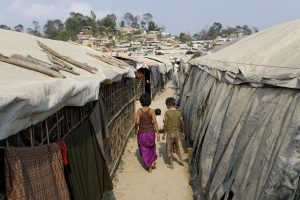Earlier this week, the United Nations refugee agency (UNHCR) released new statistics about the number of Muslim Rohingya refugees fleeing Myanmar or Bangladesh by sea in search of sanctuary abroad. According to the new data, some 3,545 people undertook perilous sea voyages in 2022, a fivefold increase on 2021, when around 700 people made similar journeys, UNHCR said in a statement Tuesday.
This increased traffic has been accompanied by a tragic increase in the number of Rohingya civilians who died or went missing at sea last year. At least 348 people failed to complete their journeys, making it one of the deadliest years for Rohingya boat voyages since 2014.
This speaks to the incredibly dangerous nature of these journeys, which take place in overladen boats that are perilously ill-equipped for the turbulent ocean journeys to Indonesia. Indeed, a large part of the death toll for 2022 was made up of the inhabitants of a boat that sunk in December, in which around 180 people were presumed dead, the UNHCR said in a statement.
Of those who took part in such journeys, the majority (32 percent) disembarked in Myanmar, followed by Malaysia (25 percent), Indonesia (24 percent), Bangladesh (10 percent), Thailand (5 percent), and Sri Lanka (3 percent).
While Rohingya have embarked on sea voyages for years in search of sanctuary and security, the new UNHCR data affirms the sense that the numbers are growing quickly. In the last two months of 2022, four boats carrying over 450 Rohingya disembarked in Aceh, Indonesia, while one boat carrying over 100 Rohingya disembarked in Sri Lanka. According to UNHCR, several vessels that set off in December remain at sea, carrying up to 157 people.
These journeys represent a melancholy coda to the shocking levels of violence and abuse that has been visited on the Rohingya people over the past decade, and particularly since 2017, when the Myanmar military drove more than 700,000 Rohingya civilians across the border into Bangladesh. Since then, around a million mostly Rohingya men, women, and children have languished in the huge refugee camps dotted around Cox’s Bazar.
Despite attempts to organize the voluntary repatriation of Rohingya to their former homes in Myanmar’s Rakhine State, such plans have stalled amid the conflict that has seized the country since the February 2021 coup. As a result, growing numbers are taking their destiny into their own hands.
“We’re hearing reports … from Rohingya about this growing sense of desperation and this anxiety about the future and really their hope for security, for protection,” UNHCR spokesperson Shabia Mantoo told journalists in Geneva. “Some of them are wanting to reunite with family members, others, their vulnerabilities are being exploited by traffickers or smugglers luring with false promises and false hope.”
The growth in sea voyages has led UNHCR and other rights groups to call for a more coordinated regional approach to the issue. “The current crisis in the Bay of Bengal and the Andaman Sea is a crisis of solidarity,” the U.N. refugee agency stated. “Without a regional response, States will continue adopting unilateral policies that endanger lives.”

































